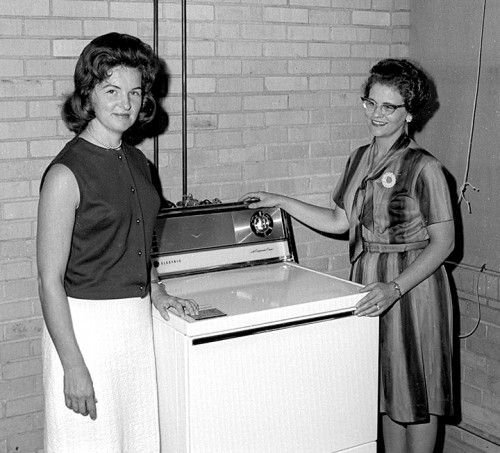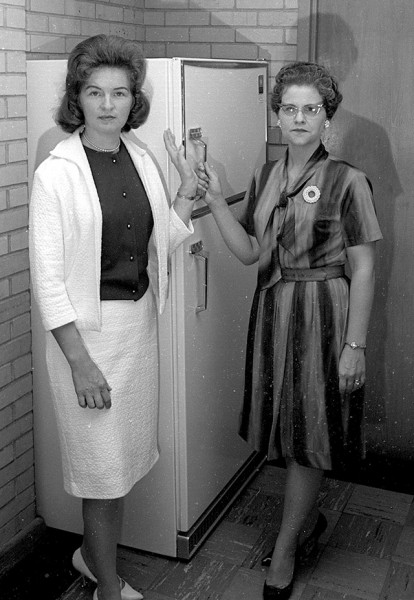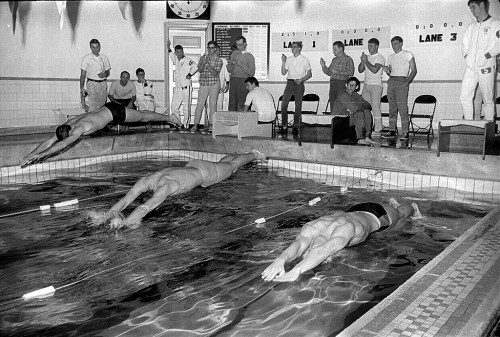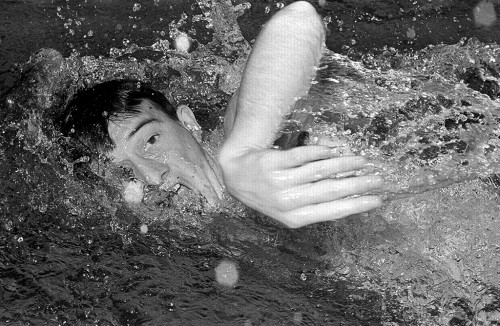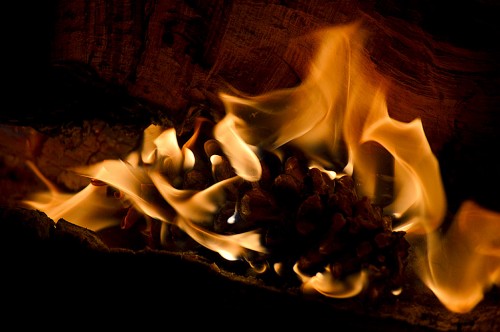 It’s been a warm October and November, but we’ve had about a dozen days so far that called for a fire in the fireplace. Tonight, possibly the last night I’ll be in Cape until the spring, is one of those nights. Weatherbug reports it is 25, headed to an overnight low of 18. I didn’t bother to look at the windchill numbers. When your nose hairs freeze, windchill is a non-factor.
It’s been a warm October and November, but we’ve had about a dozen days so far that called for a fire in the fireplace. Tonight, possibly the last night I’ll be in Cape until the spring, is one of those nights. Weatherbug reports it is 25, headed to an overnight low of 18. I didn’t bother to look at the windchill numbers. When your nose hairs freeze, windchill is a non-factor.
I noticed that Brother Mark had a box of pine cones dipped in wax in a box near the fireplace, so I tried one of them as a fire starter. It burned like a champ. (Click on the photos to make them larger. They might make you feel warmer if you live up north. Plus, they’re kinda pretty.)
I’m cheap and lazy
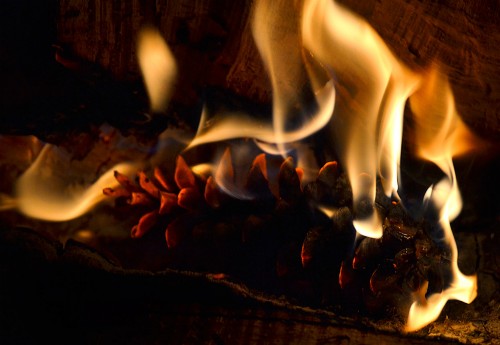 I knew the wax would enhance the burn quality of the cones, but I didn’t want to go to the trouble and expense of buying, melting and spilling the wax, so I thought I’d see how well plain ones would work.
I knew the wax would enhance the burn quality of the cones, but I didn’t want to go to the trouble and expense of buying, melting and spilling the wax, so I thought I’d see how well plain ones would work.
Mother and I cruised around until we saw some pine cones sitting on the ground under a tree in a park in Jackson.
They followed us home.
It was amazing at how easily they caught fire. (Something that you might want to think about if you have pine trees that have dropped a bunch of cones around your house.)
Just the touch of a match
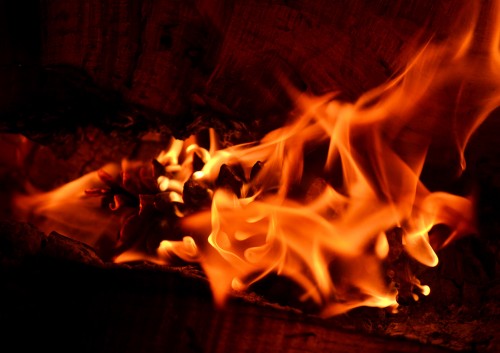 All it took was the touch of a match to get the cones to burst into flame.
All it took was the touch of a match to get the cones to burst into flame.
A thing of beauty
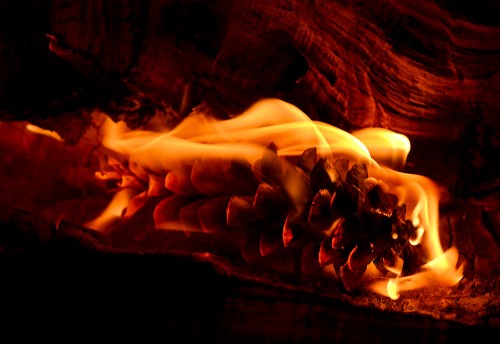 I was watching one just as the flames were dying down and the cone was a mass of glowing red. I dashed across the room for my camera, but it was one of those things that was perfect just for an instant.
I was watching one just as the flames were dying down and the cone was a mass of glowing red. I dashed across the room for my camera, but it was one of those things that was perfect just for an instant.
That’s when I threw some of these cones into the fireplace trying to duplicate what I had seen seconds before. Didn’t work: the magic had all leaked out. Some of these are nice, but not close to what that first one looked like.
How to start a fire
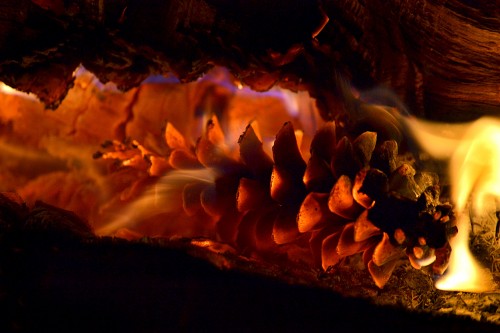 I found the fastest way to start a fire with these was to wrap half a dozen in a couple of sheets of loosely twisted newspaper. (See, newspapers ARE still good for something.)
I found the fastest way to start a fire with these was to wrap half a dozen in a couple of sheets of loosely twisted newspaper. (See, newspapers ARE still good for something.)- Put a few sticks or other light kindling on top of the newspaper.
- Light and run away (That last part is for fireworks; you don’t have to run away.)
- If you feel lucky, you could go ahead an put a log on top of the kindling when you light it, but I usually like to see that it’s going to take off first.
Oh, my aching back
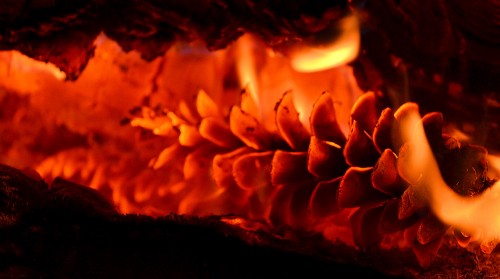 I got smart before we went on our next pine cone mission: I stopped at a local hardware store and picked up something similar to this aluminum reacher and grabber gizmo. (Buy it from this link and I’ll make a couple of pennies. Or, go to just about any hardware store and get it for about the same price.) It’s not a high precision piece of equipment and it’s not going to last forever if you pick up heavy stuff (or give it to your grandkid to play with), but Wife Lila and Mother have found it useful.
I got smart before we went on our next pine cone mission: I stopped at a local hardware store and picked up something similar to this aluminum reacher and grabber gizmo. (Buy it from this link and I’ll make a couple of pennies. Or, go to just about any hardware store and get it for about the same price.) It’s not a high precision piece of equipment and it’s not going to last forever if you pick up heavy stuff (or give it to your grandkid to play with), but Wife Lila and Mother have found it useful.
It does an excellent job of snagging pine cones.
Photo geekery
I was going to give you all kinds of information about exposures, but they were all over the place. The only constant was that I underexposed them by two stops from what the camera said was normal.
The camera looked at all the dark areas in the photo (most of which I cropped out) and said, “I want to make those areas lighter.”
I wanted the shadows to go dark, which also brought out the rich colors in the flames, so I told the camera to give it much less light than it thought it should in the theoretical world. Is there a scientific way to calculate the right exposure for something like this? Probably, but I just guessed, looked at the image, liked it, and kept shooting.
It’s a shame about the magic leaking out, though. You’ll just have to trust me when I say that first cone was the prettiest.
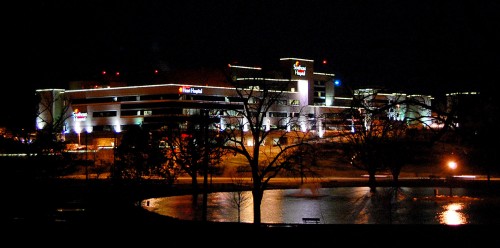 The way hospitals in Cape gobble up everything around them and grow new buildings like dandelions, this November 16, 2011, photo of Southeast Missouri Hospital may be outdated. It must have been chilly enough that nobody is sitting on the Capaha Park Lagoon park bench.
The way hospitals in Cape gobble up everything around them and grow new buildings like dandelions, this November 16, 2011, photo of Southeast Missouri Hospital may be outdated. It must have been chilly enough that nobody is sitting on the Capaha Park Lagoon park bench.
